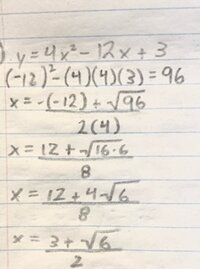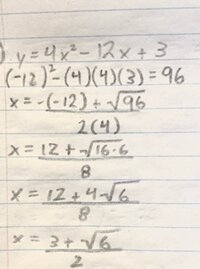AncientShape
New member
- Joined
- Jul 15, 2023
- Messages
- 4
Hello, I am just beginning to learn quadratic functions, and even though I feel decent enough at things like factoring polynomials and radicals, I'm a bit lost at the layout of some these equations. I'm using booklets with a lot of great examples that I can follow, but then the practice questions seem to throw in some curve balls and I get flustered at which direction to go. I'm needing to either factor or use root property for this specifically, but the structure of the equation isn't addressed until they move into explaining quadratic formula, which I'm not being asked to use yet, so I feel like I have no good reference on how to solve some of these questions. An example of this would be: y=4x^2-12x+3
My instinct here is to factor this using the trinomial method: 4x^2−3x−9x+3=0
=x(4x−3)−3(3x−1)=0
=(4x−3)(x−1)=0 add 3 to both sides here and divide by 4
=4x−3+3=0+3
=4x−3=0
x=3/4
add 1 to both sides: x−1=0 and x=1
This doesn't feel like the right path and I'm unsure how to tackle that using root property because the examples I look up seem too different in structure? Can anyone suggest videos that have these types of equations so I can see some breakdowns, or screw my head back on properly because I feel like I'm simply overcomplicating this?
Thank you.
My instinct here is to factor this using the trinomial method: 4x^2−3x−9x+3=0
=x(4x−3)−3(3x−1)=0
=(4x−3)(x−1)=0 add 3 to both sides here and divide by 4
=4x−3+3=0+3
=4x−3=0
x=3/4
add 1 to both sides: x−1=0 and x=1
This doesn't feel like the right path and I'm unsure how to tackle that using root property because the examples I look up seem too different in structure? Can anyone suggest videos that have these types of equations so I can see some breakdowns, or screw my head back on properly because I feel like I'm simply overcomplicating this?
Thank you.


